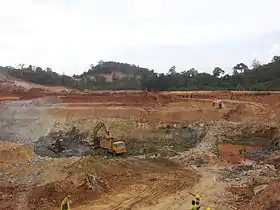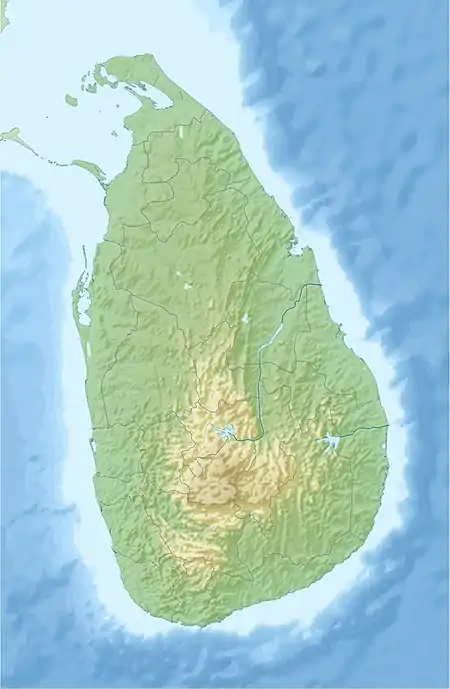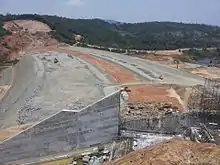Kalu Ganga Dam
The Kalu Ganga Dam is a large gravity dam, and the second vital component of the larger and more complex Moragahakanda — Kalu Ganga Project, currently under construction across the Kalu Ganga ("Black River") at Pallegama, in the Matale District of Sri Lanka. Construction of the project was launched by President Mahinda Rajapaksa on 25 January 2007.[1] The maiden waters of the dam was released in July 2018.[2]
| Kalu Ganga Dam | |
|---|---|
 Kaluganga Dam project site | |
 Location of Kalu Ganga Dam in Sri Lanka | |
| Country | Sri Lanka |
| Location | Pallegama |
| Coordinates | 07°33′35″N 80°50′09″E |
| Purpose | Irrigation |
| Status | Operational |
| Construction began | 02 April 2014 |
| Opening date | 26 December 2018 |
| Owner(s) | Mahaweli Authority |
| Dam and spillways | |
| Type of dam | Gravity dam |
| Impounds | Kalu Ganga |
| Height | 67 m (220 ft) |
| Length | 546 m (1,791 ft) |
| Reservoir | |
| Creates | Kalu Ganga Reservoir |
The larger combined project involves the construction of the Kalu Ganga Dam and Reservoir, along with the separate Moragahakanda Dam and Reservoir, for irrigation and power generation purposes. Both these sites would be located approximately 10 km (6.2 mi) apart.[3]
The total development cost for both sites totals to approximately Rs. 48.145 billion (approximately US$370 million) and is being carried out by SMEC Holdings and Sinohydro.[4][5][6]
Funding
The development of the Kalu Ganga segment would cost US$167 million. 22% or US$37 million of this is funded by the Kuwait Fund, 27.5% or US$46 million is funded by the Saudi Fund for Development, while the rest if borne by the Government of Sri Lanka. The funds will be payable in 20 years, including a 5-year grace period.[7]
The funding from OPEC will carry an interest rate of 3.2%, and a service charge of 1% on the principle amount withdrawn and outstanding.[7]
Dam and reservoir

The primary Kalu Ganga Dam will be a 67 m (220 ft) high concrete gravity dam, measuring 546 m (1,791 ft) in length. To support the new Kalu Ganga Reservoir created by the dam, two additional saddle dams will also be created to contain the reservoir. The primary dam and saddle dams are estimated to cost approximately US$102.2 million.[5][7]
In addition to using the reservoir's water for irrigation, a percentage of it would be consistently transferred via tunnel to the Moragahakanda Reservoir for further irrigation uses and hydroelectricity generation.[1]
Environmental and Social Impact of the Dam Construction
A large area of forest east of Pallegama has been cleared for the construction of the dam and even more so for the construction of a new residential and agricultural colony east of the dam. The forest area cleared is adjoining Wasgamuwa National Park and linked the forests on the eastern side of Knuckles Mountain Range with the Wasgamuwa National Park. Elephants and other wildlife used to inhabit this area and used it as corridor. There are attempts to minimize environmental impact by reforesting catchment areas, and declaration of elephant corridors to Wasgamuwa, Girithale, Mineriya national parks.[8]
Several old villages, including Pallegama and Rambukoluwa, have to be abandoned and all the residents have to relocate to the new colony, about 5 to 10 kilometers northeast of Pallegama. Each family is compensated with two acres of land, 1.5 acres of paddy land and half an acre in the residential area to construct a new house.[9]


See also
| Wikimedia Commons has media related to Kalu Ganga Dam. |
References
- "Work on Moragahakanda Kalu Ganga Project progressing satisfactorily". ITN News. 6 February 2013. Retrieved 14 January 2014.
- "President to inaugurate filling of Kalu Ganga reservoir tomorrow". The Sunday Times. Retrieved 3 April 2018.
- "Moragahakanda and Kaluganga Development Project" (PDF). Ministry of Finance and Planning. p. 2. Archived from the original (PDF) on 16 January 2014. Retrieved 14 January 2014.
- "SMEC Wins Major Project with World's Largest Hydroelectric Company". SMEC Holdings. 23 October 2012. Retrieved 14 January 2014.
- "Moragahakanda project on schedule". LankaNewspapers.com. 8 January 2014. Retrieved 14 January 2014.
- Shirajiv Sirimane (3 June 2013). "Moragahakanda multi purpose project construction on track". Retrieved 14 January 2014.
- "Sri Lanka negotiates OPEC funds for irrigation project". LBO.lk. 5 February 2010. Archived from the original on 16 January 2014. Retrieved 15 January 2014.
- Warushamana, Gamini. “Development apace - impact on socio environment minimised” in Sunday Observer Online, 21 July 2013. Retrieved 3 March 2017.
- Warushamana, Gamini. “Development apace - impact on socio environment minimised” in Sunday Observer Online, 21 July 2013. Retrieved 3 March 2017.